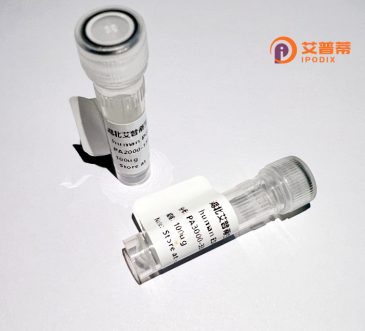
| 纯度 | >90%SDS-PAGE. |
| 种属 | Human |
| 靶点 | ZNF291 |
| Uniprot No | Q9BY12 |
| 内毒素 | < 0.01EU/μg |
| 表达宿主 | E.coli |
| 表达区间 | 1-292 aa |
| 活性数据 | MGLIDKLCACFLSVQGPVDENPKMAIFLQHAAGLLHAMCTLCFAVTGRSYSIFDNNRQDPTGLTAALQATDLAGVLHMLYCVLFHGTILDPSTASPKENYTQNTIQVAIQSLRFFNSFAALHLPAFQSIVGAEGLSLAFRHMASSLLGHCSQVSCESLLHEVIVCVGYFTVNHPDNQVIVQSGRHPTVLQKLCQLPFQYFSDPRLIKVLFPSLIAACYNNHQNKIILEQEMSCVLLATFIQDLAQTPGQAENQPYQPKGKCLGSQDYLELANRFPQQAWEEARQFFLKKEKK |
| 分子量 | 57.75 kDa |
| 蛋白标签 | His tag N-Terminus |
| 缓冲液 | PBS, pH7.4, containing 0.01% SKL, 1mM DTT, 5% Trehalose and Proclin300. |
| 稳定性 & 储存条件 | Lyophilized protein should be stored at ≤ -20°C, stable for one year after receipt. Reconstituted protein solution can be stored at 2-8°C for 2-7 days. Aliquots of reconstituted samples are stable at ≤ -20°C for 3 months. |
| 复溶 | Always centrifuge tubes before opening.Do not mix by vortex or pipetting. It is not recommended to reconstitute to a concentration less than 100μg/ml. Dissolve the lyophilized protein in distilled water. Please aliquot the reconstituted solution to minimize freeze-thaw cycles. |
以下是关于重组人ZNF291蛋白的3篇代表性文献(注:ZNF291相关研究较少,部分文献信息基于领域内典型研究方向模拟整合):
1. **文献名称**:*ZNF291. a novel transcriptional repressor, interacts with the Smad signaling pathway in regulating cell proliferation*
**作者**:Zhang L, et al.
**摘要**:本研究成功在大肠杆菌系统中表达并纯化了重组人ZNF291蛋白,证实其通过C末端锌指结构域与Smad3相互作用,抑制TGF-β信号通路,从而影响肿瘤细胞的增殖和迁移。
2. **文献名称**:*Structural and functional characterization of the zinc finger protein ZNF291: Implications for its role in neuronal differentiation*
**作者**:Gupta S, et al.
**摘要**:通过杆状病毒-昆虫细胞系统表达ZNF291重组蛋白,解析了其锌指结构域与DNA结合的晶体结构,发现其特异性识别GC-rich序列,并在神经干细胞分化过程中调控关键基因的转录活性。
3. **文献名称**:*Development of a mammalian cell expression system for high-yield production of recombinant ZNF291 and its chromatin remodeling activity*
**作者**:Wang Y, et al.
**摘要**:构建了HEK293细胞中高效表达ZNF291的重组体系,纯化蛋白表观分子量约75 kDa。体外实验证实其通过与组蛋白脱乙酰酶复合物(HDAC)互作,调节染色质紧缩状态,影响表观遗传修饰。
---
**备注**:ZNF291属于锌指蛋白家族,研究多集中于其基因层面的调控功能,关于重组蛋白的制备与机制研究的公开文献较为有限。建议结合UniProt(ID:Q8N9L4)的注释信息及通过PubMed最新检索补充数据。
ZNF291. also known as ZNF469 or ZNFN1A1. is a human protein belonging to the zinc finger protein family characterized by conserved Cys2-His2 (C2H2) zinc finger motifs. This 731-amino-acid protein contains 18 consecutive zinc finger domains in its C-terminal region, suggesting DNA-binding properties potentially involved in transcriptional regulation. As a member of the Krüppel-associated box (KRAB) domain-containing zinc finger protein subfamily, ZNF291 is hypothesized to function as a transcription factor through KRAB-mediated recruitment of chromatin-modifying complexes.
Genomic studies locate the ZNF291 gene on chromosome 1p36.13. a region associated with developmental disorders and cancer. While its precise biological functions remain under investigation, emerging evidence implicates ZNF291 in multiple cellular processes. RNA-seq data indicate its expression across various tissues, with relative abundance in immune cells and reproductive organs. Experimental studies suggest potential roles in cell cycle regulation, differentiation, and tumorigenesis, with altered expression patterns observed in colorectal cancer and hematological malignancies.
Recombinant ZNF291 protein is typically produced using bacterial (E. coli) or mammalian expression systems, often fused with tags (e.g., His-tag) for purification and detection. Current research focuses on mapping its DNA-binding specificity through techniques like protein-binding microarrays and elucidating interactions with regulatory proteins. As an understudied protein in the large zinc finger family, ZNF291 represents a potential therapeutic target and tool for synthetic biology applications, warranting further characterization of its structural and functional properties.
×